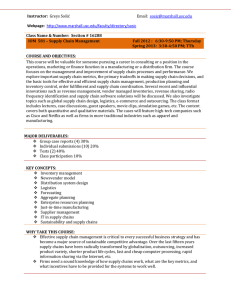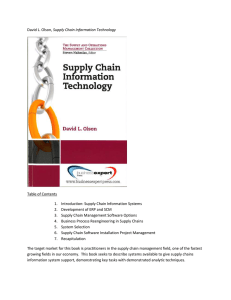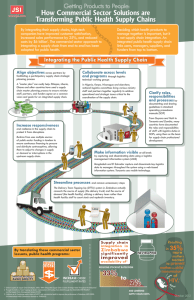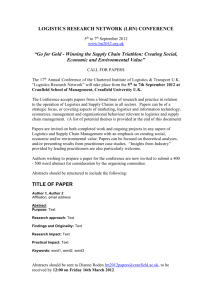Interview: Professor Alan Harrison Logistics Management and Strategy:
advertisement
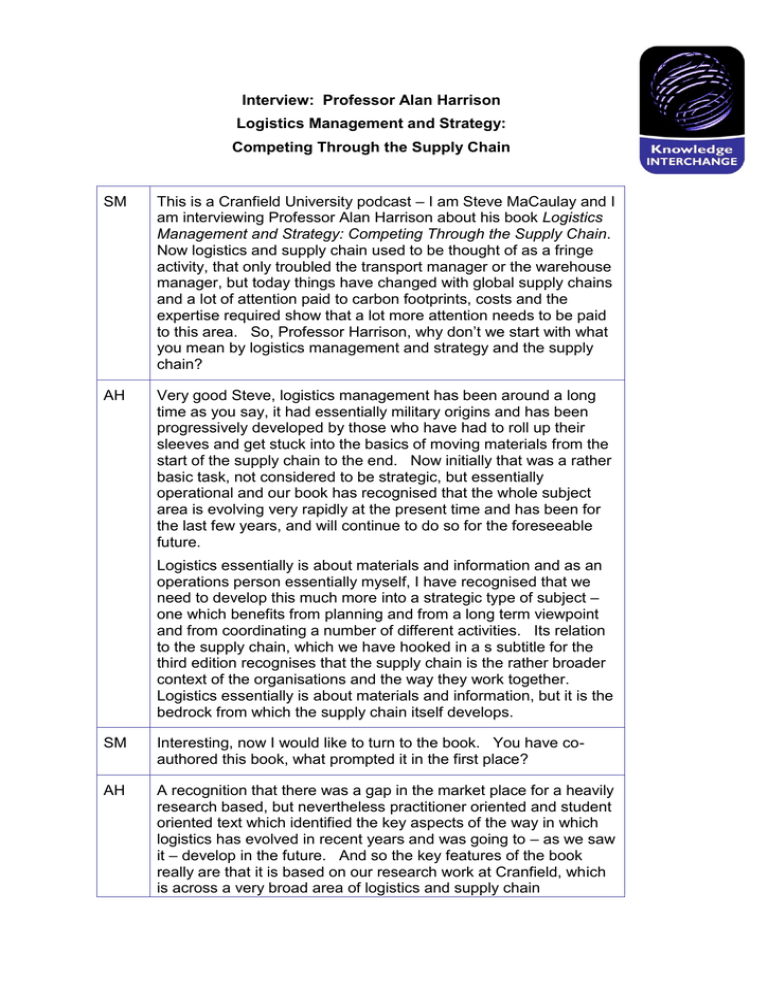
Interview: Professor Alan Harrison Logistics Management and Strategy: Competing Through the Supply Chain SM This is a Cranfield University podcast – I am Steve MaCaulay and I am interviewing Professor Alan Harrison about his book Logistics Management and Strategy: Competing Through the Supply Chain. Now logistics and supply chain used to be thought of as a fringe activity, that only troubled the transport manager or the warehouse manager, but today things have changed with global supply chains and a lot of attention paid to carbon footprints, costs and the expertise required show that a lot more attention needs to be paid to this area. So, Professor Harrison, why don’t we start with what you mean by logistics management and strategy and the supply chain? AH Very good Steve, logistics management has been around a long time as you say, it had essentially military origins and has been progressively developed by those who have had to roll up their sleeves and get stuck into the basics of moving materials from the start of the supply chain to the end. Now initially that was a rather basic task, not considered to be strategic, but essentially operational and our book has recognised that the whole subject area is evolving very rapidly at the present time and has been for the last few years, and will continue to do so for the foreseeable future. Logistics essentially is about materials and information and as an operations person essentially myself, I have recognised that we need to develop this much more into a strategic type of subject – one which benefits from planning and from a long term viewpoint and from coordinating a number of different activities. Its relation to the supply chain, which we have hooked in a s subtitle for the third edition recognises that the supply chain is the rather broader context of the organisations and the way they work together. Logistics essentially is about materials and information, but it is the bedrock from which the supply chain itself develops. SM Interesting, now I would like to turn to the book. You have coauthored this book, what prompted it in the first place? AH A recognition that there was a gap in the market place for a heavily research based, but nevertheless practitioner oriented and student oriented text which identified the key aspects of the way in which logistics has evolved in recent years and was going to – as we saw it – develop in the future. And so the key features of the book really are that it is based on our research work at Cranfield, which is across a very broad area of logistics and supply chain Professor Alan Harrison management generally and it is also written in a very clear and very easy to understand way. So we have gone the extra mile to make the textbook very clearly set out, the definitions and so on are all clearly stated at the correct points in the development of the text. SM Now you mentioned to the third edition, you added some information about the supply chain and that context – I imagine that you have seen since the first edition of this book quite a big development in this field. AH There has been an enormous development and it is continuing rapidly into the future. I can see several more editions, or at least we are starting to think about how those might evolve. I think that particularly for the third edition the kind of key features that we have developed there are to do more on the management of risk in supply chains internationally, the recognition that the issues of corporate responsibility and the – as we call it – the responsible supply chain are becoming much more of a feature. We have chosen the colour green for the cover of the text, not out of the blue as it were from that point, but to emphasise the fact that logistics is becoming more and more an area of opportunity for developing the more socially responsible supply chain of the future and I think the third area in which we have developed in the third edition, is that of coordination between supply chain partners. I think that is an enormous area which we are still learning an enormous amount about. Its very difficult to coordinate so many activities across such a broad range of processes which might start in China and end somewhere in Europe, so we have paid a lot of attention to that as well. SM Now, if I get down to some nitty gritty about some of the issues, one of the words that kind of struck me that you use is the concept of an agile supply chain and also some words push and pull and alignment. I wonder if you could expand on some of these, so I can get a real feel for some of the key issues involved. AH Sure – Chapter six of the book addresses the issue of just in time and of the task of coordinating material business between supply chain partners generally. Push and pull is part of the just in time thinking, that is, you only make when the customer, the next process, actually asks you to do so. The lean aspect of the way in which operations should be managed has received an enormous amount of attention over the last thirty years and was perhaps popularised by the Japanese, it has more recently been idealised, I would say, by publications like Machines That Changed the World and Lean Thinking. Lean Thinking is fine to a point, but equally today we have to recognise that many supply chains do not have the benefit of stable schedules and reasonable forecast accuracy of what is Knowledge Interchange Podcasts Page 2 Professor Alan Harrison going to happen with demand in the future and they have to lay out capabilities which enable those supply chains to respond rapidly to really quite major changes in demand, up or down, and also in terms of the mix of products which are encapsulated within that supply chain. And that is where the idea of agility comes in, which is that of developing the capabilities to be able to support short product lifecycles, increasing product variety and increasing difficulty of forecasting demand. SM Now, we have dealt with some key challenges and important concepts. I would like to try and home in on some of the areas about your view on where organisations are today and then we will have a look at where they need to develop. So if you were to take a kind of temperature check and say we have got all these challenges ahead, how are organisations actually tackling them today? AH Our research over the last seven years has illustrated with a large number of blue chip companies based across Europe, but all is by no means the integrated synchronised world that we foresee as being the supply chain of the future. Far too often today, there are examples or pockets of best practice which help to show what is possible, but rarely have these been extended much beyond a dyadic relationship between a supplier and its immediate customer, for example. And the opportunities therefore for better alignment across a broader network of supply chain partners is clearly one of the competitive opportunities for the future and we are going to see supply chains moving towards that – there is no question of that because the competitive imperatives will drive organisations towards that. There are a large number of barriers to that today, but we will gradually get rid of those. SM Now, if we look at the challenges, if we look at the state of play, are there any exemplars, people who would pick out and say, these people are ahead of the game, they are actually managing in the way that we believe others should be following? AH Well, one can look at certain features of certain supply chains and hold those up of exemplars of what could be. Automotive supply chains which have often been held up as being excellent examples of good practice and so on, frequently are not and we end up with almost car parks of products which is not actually suitable, or not what the customer wants, in disused airfields around Europe awaiting sale. But nevertheless the prestige manufacturers such as BMW have illustrated what a well orchestrated supply chain can actually look like and there, providing the customer is prepared to wait, it is possible to actually orchestrate the supply the chain from start to finish in a reasonably well integrated way. And as a result BMW has one of the leanest supply chains around, although it never actually set out to do that, but the made to order situation Knowledge Interchange Podcasts Page 3 Professor Alan Harrison which we have got with BMW, that is where the customer individually orders the product and is prepared to wait for those, greatly helps to facilitate that process of coordinating the proceeding operations. So when the car is actually assembled finally at the end of the supply chain, it is already in a saleable situation because that is actually what the customer actually wanted. Now the transfer of that model into volume production is proving to be very difficult, while we have initiatives like the three day car to try to achieve something similar, that is being able to place an order and to receive the product that you want within a short period of time, that model is still proving to be very illusive in an essentially mass market type of industry. If one looks into other sectors, then often there are some very good examples of what individual organisations have done to help facilitate that. In the UK, the grocery sector for example is extremely efficient in certain areas – particularly in the high volume, low variety end of their business in terms of adopting rapid response logistics to replenishing what the customer has ordered. So I think that when looks around there are a number of examples of good practice which will gradually come together and develop the supply chain of the future, but as I said there are a number of inhibitors to achieving that. SM Now, I would like to turn to the future, new ways of working. A couple of things I noticed in the book, I would like you to expand on: supplier rationalisation strategy and joint network activities. AH The thinking behind supplier rationalisation is more strategic perhaps than it sounds – sounds like you are just cutting out suppliers, well for an individual organisation embedded within the network, the process of actually reducing the number of suppliers with which it operates has a number of attractive features. Essentially it means that you are able to spend more time on the more limited number of key suppliers and get them to in turn look after the suppliers who are further up stream – in other words, to manage their part of the network on your behalf, and we have seen that as a model develop considerably over the last ten years or so and the benefits are that the simplification of material movements and typically lower costs and better responsiveness because often suppliers are better able to coordinate the upstream activities than the focal firm was itself, and so I think that that is one area where the network coordination is improving a lot and if one then extends that out into the network itself as you were talking about, then I think that the opportunity here is to coordinate network activities in a better and more controlled and synchronised way. Ideally when the customer buys a product at the end of a particular supply chain, puts money back into it so that that can be shared amongst the supply chain partners that should automatically promote the development of a new product and its replenishment to take the Knowledge Interchange Podcasts Page 4 Professor Alan Harrison place of that which has been sold and that synchronisation process will, I think, gradually embed itself into the way in which supply chains of the future operate. SM You have mentioned about supply chains of the future – I would like you to take a crystal ball now and imagine you are writing edition six of this book and things have moved on quite a bit – what do you see the future will look like? AH I certainly see the future as being much more coordinated, this is going to place considerable pressure onto the development of IT systems which are capable of supporting the heavy duty communications that are going to become a more distinct feature of the way in which supply chains of the future operate. I think the other major area which is going to develop is that of human relations between players within a supply chain. So those are going to be the two major enablers of supply chains of the future and we are going to see those being applied to the development of a much more integrated sequence of supply chain processes across a given network. SM So finally, if you were to sit down in front of a group of experienced logistics and supply chain managers, what advice would you like to leave them with? AH I often think that the ‘what’ of the supply chain of the future is a much easier question to answer than the ‘how the hell are we going to get there?’ and so I think that the gap that we are seeing today between the vision of what supply chains are going to be and the reality of the relatively unaligned and disintegrated processes that we see in typical supply chains of today is the recognition of what actually needs to be done and where the priority is going to lie. Clearly supply chains of the future are entities that no individual organisation is going to be able to create by themselves – it is essentially going to be a partnership process between the members of a network and so therefore the need for collaboration across a much broader front than currently is the case is going to be one of the features in which we bridge the gap between now and the future. But I think that the other big area that we need to concentrate on is the development of new supply chain managers of the future. Here of course, Cranfield has a major role to play in our Masters programmes and our Exec programmes will, I hope, be a major vehicle for developing and recognising in managers what needs to be done in order to broaden their outlook and to recognise how they are going to overcome barriers in going from where we are now to where we will be. SM Some interesting challenges ahead – thank you very much Alan. Knowledge Interchange Podcasts Page 5 Cranfield School of Management Produced by the Learning Services Team Cranfield School of Management © Cranfield University 2008
